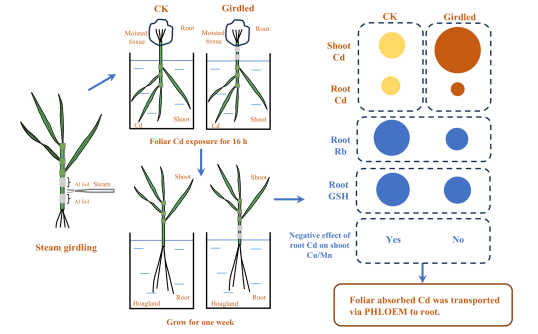Wheat is a globally important food crop; its leaves can directly absorb cadmium from atmospheric deposition. However, the transport pathways of foliar-absorbed cadmium within wheat plants remain poorly understood. Recent research by master graduate student Wang Liping of School of Environmental Engineering made substantial progress on this issue. Hydroponic wheat seedlings were steam girdled on stem to disrupt its phloem transport function, then the plant shoots were kept in a cadmium and rubidium (a phloem transport indicator element) solution for 16 hours for foliar Cd exposure, the plants then grew in Hoagland solution for one week. Results found that cadmium content in girdled wheat leaves increased by over 200%, while root cadmium content decreased by approximately 50% compared with the ungirdled treatments. Similarly, root rubidium content decreased by about 50%. These findings indicate that phloem plays an important role in the transport of foliar-absorbed Cd. This research provides critical insights into understanding the transport mechanisms of cadmium absorbed by wheat leaves.

Graphical Abstract

Wheat seedlings during the experiment
The results were recently published in Science of the Total Environment (Impact Factor: 8.2), entitled “Investigation of Phloem Transport of Foliar-Absorbed Cd in Wheat” (DOI: 10.1016/j.scitotenv.2025.179496), co-authored by professor Liping Li, master student Liping Wang from Henan University of Technology and the Henan International Joint Laboratory for Environmental Pollution Remediation and Grain Quality Safety, and professor James A. Ippolito from The Ohio State University, US. Authors also include Dr. Li Ma, Dr. Kunyan Qiu and undergraduate Junxiao Jiang of Henan University of Technology.
Contributed by: Liping Wang
Reviewed by: Liping Li
Approved by: Dongjin Wan
